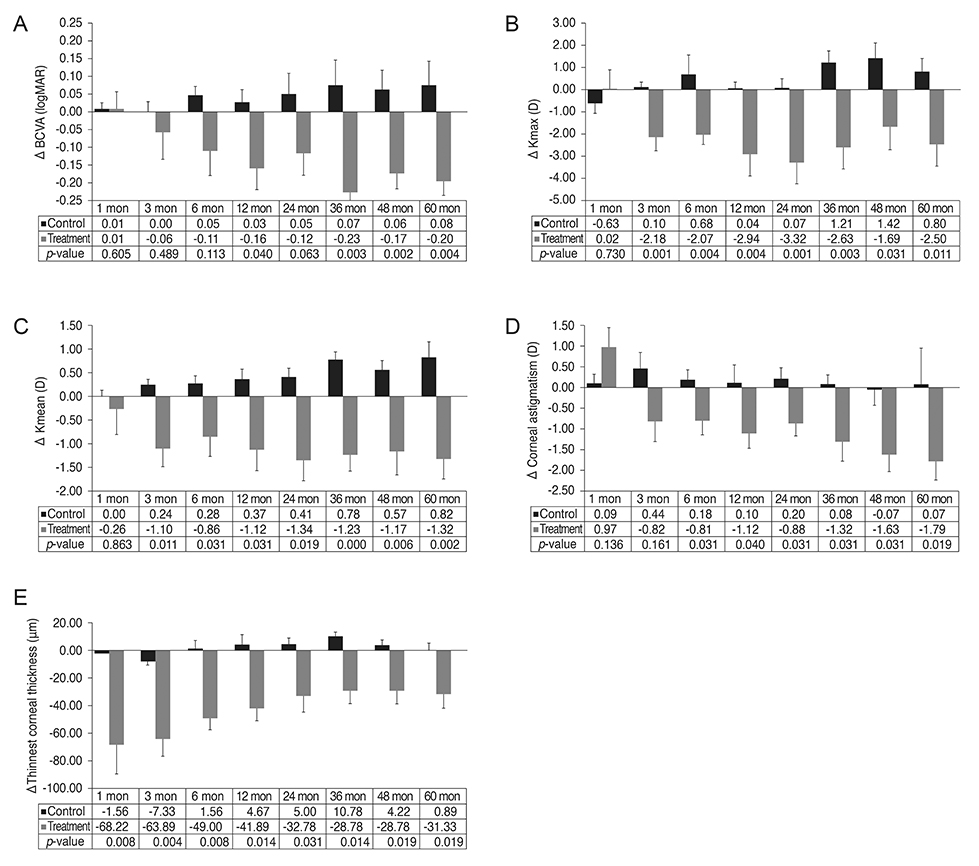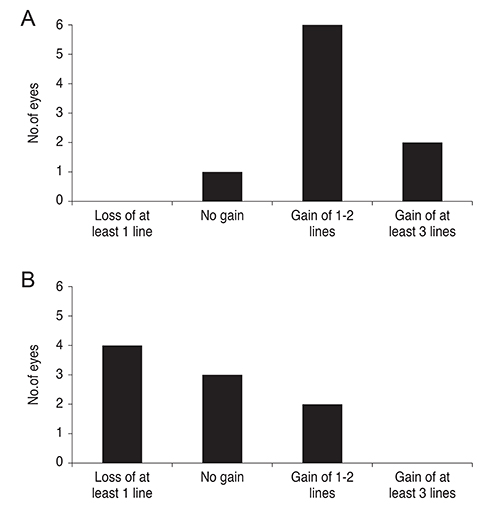Korean J Ophthalmol.
2016 Oct;30(5):326-334. 10.3341/kjo.2016.30.5.326.
The Long-term Clinical Outcome after Corneal Collagen Cross-linking in Korean Patients with Progressive Keratoconus
- Affiliations
-
- 1Department of Ophthalmology, Kyung Hee University Medical Center, Kyung Hee University School of Medicine, Seoul, Korea. khjinmd@khmc.or.kr
- KMID: 2353825
- DOI: http://doi.org/10.3341/kjo.2016.30.5.326
Abstract
- PURPOSE
To evaluate the long-term clinical effectiveness and safety of corneal collagen cross-linking (CXL) in progressive keratoconus compared with untreated contralateral eyes.
METHODS
In this retrospective study, nine eyes of nine patients with progressive keratoconus who received CXL (treatment group) and nine untreated contralateral eyes with keratoconus (control group) were included. All patients were followed for at least 5 years and assessed with best-corrected visual acuity, maximum keratometry, mean keratometry, corneal astigmatism, and corneal thickness. Clinical data were collected preoperatively and at 1, 3, 6, 12, 24, 36, 48, and 60 months, postoperatively.
RESULTS
Mean best-corrected visual acuity improved significantly from 0.58 ± 0.37 logarithm of minimum angle of resolution preoperatively to 0.39 ± 0.29 logarithm of minimum angle of resolution at 5 years after corneal CXL (p = 0.012). There was significant flattening of the maximum keratometry and mean keratometry from preoperative values of 63.39 ± 10.89 and 50.87 ± 6.27 diopter (D) to postoperative values of 60.89 ± 11.29 and 49.54 ± 7.23 D, respectively (p = 0.038, 0.021). Corneal astigmatism decreased significantly from 7.20 ± 1.83 D preoperatively to 5.41 ± 1.79 D postoperatively (p = 0.021). The thinnest corneal thickness decreased from 434.00 ± 54.13 to 365.78 ± 71.58 µm during 1 month after treatment, then increased to 402.67 ± 52.55 µm at 5 years, which showed a statistically significant decrease compared to the baseline (p = 0.020). In the untreated contralateral eyes, mean keratometry increased significantly at 2 years compared with the baseline (p = 0.043).
CONCLUSIONS
CXL seems to be an effective and safe treatment for halting the progression of keratoconus over a long-term follow-up period of up to 5 years in progressive keratoconus.
Keyword
MeSH Terms
Figure
Reference
-
1. Rabinowitz YS, Garbus J, McDonnell PJ. Computer-assisted corneal topography in family members of patients with keratoconus. Arch Ophthalmol. 1990; 108:365–371.2. Rabinowitz YS. Keratoconus. Surv Ophthalmol. 1998; 42:297–319.3. Espandar L, Meyer J. Keratoconus: overview and update on treatment. Middle East Afr J Ophthalmol. 2010; 17:15–20.4. Raiskup-Wolf F, Hoyer A, Spoerl E, Pillunat LE. Collagen crosslinking with riboflavin and ultraviolet-A light in keratoconus: long-term results. J Cataract Refract Surg. 2008; 34:796–801.5. Wollensak G. Crosslinking treatment of progressive keratoconus: new hope. Curr Opin Ophthalmol. 2006; 17:356–360.6. Kim HS, Lee TH, Lee KH. Intracorneal ring segment implantation for the management of keratoconus: short-term safety and efficacy. J Korean Ophthalmol Soc. 2009; 50:1505–1509.7. Mencucci R, Marini M, Paladini I, et al. Effects of riboflavin/UVA corneal cross-linking on keratocytes and collagen fibres in human cornea. Clin Experiment Ophthalmol. 2010; 38:49–56.8. Spoerl E, Wollensak G, Seiler T. Increased resistance of crosslinked cornea against enzymatic digestion. Curr Eye Res. 2004; 29:35–40.9. Wollensak G, Spoerl E, Seiler T. Stress-strain measurements of human and porcine corneas after riboflavin-ultraviolet-A-induced cross-linking. J Cataract Refract Surg. 2003; 29:1780–1785.10. Wollensak G, Wilsch M, Spoerl E, Seiler T. Collagen fiber diameter in the rabbit cornea after collagen crosslinking by riboflavin/UVA. Cornea. 2004; 23:503–507.11. Wollensak G, Spoerl E, Seiler T. Riboflavin/ultraviolet-a-induced collagen crosslinking for the treatment of keratoconus. Am J Ophthalmol. 2003; 135:620–627.12. Caporossi A, Mazzotta C, Baiocchi S, Caporossi T. Long-term results of riboflavin ultraviolet a corneal collagen cross-linking for keratoconus in Italy: the Siena eye cross study. Am J Ophthalmol. 2010; 149:585–593.13. Grewal DS, Brar GS, Jain R, et al. Corneal collagen cross-linking using riboflavin and ultraviolet-A light for keratoconus: one-year analysis using Scheimpflug imaging. J Cataract Refract Surg. 2009; 35:425–432.14. Koller T, Iseli HP, Hafezi F, et al. Scheimpflug imaging of corneas after collagen cross-linking. Cornea. 2009; 28:510–515.15. Vinciguerra P, Albe E, Trazza S, et al. Refractive, topographic, tomographic, and aberrometric analysis of keratoconic eyes undergoing corneal cross-linking. Ophthalmology. 2009; 116:369–378.16. Vinciguerra P, Albe E, Trazza S, et al. Intraoperative and postoperative effects of corneal collagen cross-linking on progressive keratoconus. Arch Ophthalmol. 2009; 127:1258–1265.17. Wittig-Silva C, Whiting M, Lamoureux E, et al. A randomized controlled trial of corneal collagen cross-linking in progressive keratoconus: preliminary results. J Refract Surg. 2008; 24:S720–S725.18. Wittig-Silva C, Chan E, Islam FM, et al. A randomized, controlled trial of corneal collagen cross-linking in progressive keratoconus: three-year results. Ophthalmology. 2014; 121:812–821.19. Nottingham J, editor. Practical observations on conical cornea: and on the short sight, and other defects of vision connected with it. London: John Churchill;1854. p. 23–26.20. Romero-Jimenez M, Santodomingo-Rubido J, Wolffsohn JS. Keratoconus: a review. Cont Lens Anterior Eye. 2010; 33:157–166.21. Tomkins O, Garzozi HJ. Collagen cross-linking: strengthening the unstable cornea. Clin Ophthalmol. 2008; 2:863–867.22. Hassan Z, Szalai E, Modis L Jr, et al. Assessment of corneal topography indices after collagen crosslinking for keratoconus. Eur J Ophthalmol. 2013; 23:635–640.23. Poli M, Cornut PL, Balmitgere T, et al. Prospective study of corneal collagen cross-linking efficacy and tolerance in the treatment of keratoconus and corneal ectasia: 3-year results. Cornea. 2013; 32:583–590.24. Lee P, Jin KH. Clinical results of riboflavin and ultraviolet-A -induced corneal cross-linking for progressive keratoconus in Korean patients. J Korean Ophthalmol Soc. 2011; 52:23–28.25. Noh SJ, Ahn JM, Han KE, Seo KY. Changes in corneal keratometry readings after corneal collagen cross-linking using alcohol in keratoconus patients. J Korean Ophthalmol Soc. 2012; 53:1591–1596.26. Zadnik K, Mannis MJ, Johnson CA, Rich D. Rapid contrast sensitivity assessment in keratoconus. Am J Optom Physiol Opt. 1987; 64:693–697.27. Kanellopoulos AJ, Asimellis G. Revisiting keratoconus diagnosis and progression classification based on evaluation of corneal asymmetry indices, derived from Scheimpflug imaging in keratoconic and suspect cases. Clin Ophthalmol. 2013; 7:1539–1548.28. Sabesan R, Yoon G. Neural compensation for long-term asymmetric optical blur to improve visual performance in keratoconic eyes. Invest Ophthalmol Vis Sci. 2010; 51:3835–3839.29. Greenstein SA, Shah VP, Fry KL, Hersh PS. Corneal thickness changes after corneal collagen crosslinking for keratoconus and corneal ectasia: one-year results. J Cataract Refract Surg. 2011; 37:691–700.
- Full Text Links
- Actions
-
Cited
- CITED
-
- Close
- Share
- Similar articles
-
- Clinical Results of Riboflavin and Ultraviolet-A-induced Corneal Cross-linking for Progressive Keratoconus in Korean Patients
- Corneal Collagen Crosslinking in Progressive Keratoconus
- Ten-year Results after Conventional Corneal Cross-linking in Korean Patients with Progressive Keratoconus
- Changes in Corneal Keratometry Readings after Corneal Collagen Cross-Linking Using Alcohol in Keratoconus Patients
- Long-term Effects and Prognostic Factors of Accelerated Cross-Linking with Retention Ring-assisted Riboflavin Application on Keratoconus Progression



